The Monstera deliciosa, often simply called Monstera, is a tropical plant native to the rainforests of Central America. Scientifically classified within the Araceae family, this striking plant is known for its unique, split leaves and its ability to adapt to various indoor conditions. In a controlled environment, Monstera deliciosa usually grows to a height of 6 to 10 feet and showcases a climbing habit facilitated by aerial roots.
Why is your Monstera growing sideways instead of upwards? The most common reason for this atypical growth direction is insufficient light, leading the plant to stretch out in search of better lighting conditions. Addressing this issue is crucial for the balanced, vertical growth of your Monstera.
This article covers a comprehensive range of factors that influence the growth direction of your Monstera. From light conditions, space, and pruning techniques to soil quality, pests, and even genetic factors, we’ll guide you through actionable solutions for each contributing factor. You’ll learn not just how to correct sideways growth but also how to optimize the overall health and beauty of your Monstera.
1. The Prime Suspect: Why Light Matters Most
When it comes to solving the sideways growth mystery of your Monstera, think of light as your prime suspect. It’s not just about turning on a light switch; there are various factors at play here.
You remember photosynthesis from school, right? It’s the process by which plants convert light into energy. Without sufficient light, your Monstera can’t perform photosynthesis effectively. This leads to weaker stems and leaves, which in turn makes your Monstera more likely to grow sideways.

Phototropism is the phenomenon that explains why your Monstera grows towards the light. In a low-light environment, your Monstera will stretch itself out to find a light source, often leading to unbalanced and sideways growth.
Types of Light and Their Impact
- Direct Light: Generally too harsh for Monsteras and can cause leaf burn.
- Indirect Light: Ideal for Monsteras; bright but not directly hitting the plant.
- Low Light: Not sufficient for healthy growth and likely leads to sideways growth.
| Light Type | Effects on Monstera | Recommended? |
|---|---|---|
| Direct | Leaf burn | No |
| Indirect | Healthy growth | Yes |
| Low | Sideways growth | No |
How to Fix the Light Problem
- Light Meters: These gadgets measure the amount of light in a given area and can help you find the ideal location for your Monstera.
- Artificial Lights: LED grow lights can supplement natural light, especially during winter months.
- Light Rotation: Regularly rotate your Monstera so that all sides get equal exposure to light.
2. Room to Grow: The Impact of Limited Space
Just as you’d struggle to stretch out in a cramped apartment, your Monstera needs room to grow to achieve its full, upright potential.
Roots are the foundation of any plant. When the roots of your Monstera are cramped, they can’t provide the support the plant needs for upward growth. Instead, the plant starts growing sideways to find room.
When a plant is “root-bound,” its roots have completely taken up the space within the pot, often circling around the bottom. This makes it difficult for the plant to take up nutrients and water, leading to poor growth and even sideways growth.
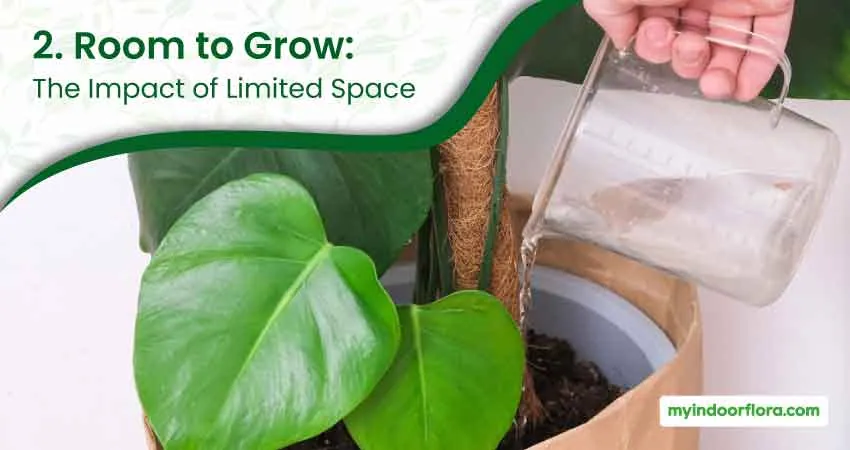
Signs Your Monstera is Cramped
- Slow Growth: A clear sign that your Monstera is uncomfortable.
- Yellowing Leaves: Could be a sign of stress due to limited space.
- Visible Roots: Roots coming out of the drainage holes are a dead giveaway.
| Sign | Likely Cause | Solution |
|---|---|---|
| Slow Growth | Limited space | Repotting |
| Yellow Leaves | Stress | Check for root-bound condition and repot if needed |
| Visible Roots | Root-bound | Immediate repotting |
Solutions for Space Issues
- Repotting: Ideally, you should be repotting your Monstera every 18–24 months. Use a pot that is at least 2 inches larger in diameter than the current one.
- Root Pruning: This is a bit more advanced, but if you’re comfortable, you can prune some of the roots to give your Monstera a bit more breathing room.
- Pruning the Foliage: Sometimes, trimming the leaves and stems can help the plant focus its energy on root growth, which can later support more balanced upward growth.
3. Watering and Nutritional Balance: Your Plant’s Diet
Proper watering and nutrition aren’t just buzzwords; they’re the bread and butter—or should we say, the “water and sunlight”—of your Monstera’s health. Let’s dive into the nitty-gritty details.
Water isn’t just H2O for plants; it’s the medium through which they absorb essential nutrients from the soil. Inadequate or excessive watering can disrupt this delicate balance, leading to various growth issues, including our prime concern: sideways growth.
Plants need a variety of nutrients, including macronutrients like nitrogen, phosphorus, and potassium, and micronutrients like calcium and magnesium. Each of these plays a unique role in plant health, from root development to leaf growth.
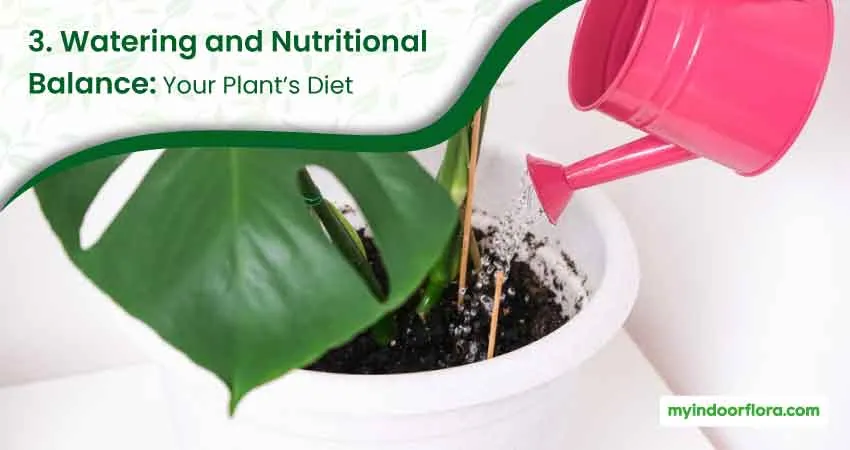
| Nutrient | Function |
|---|---|
| Nitrogen | Leaf growth and green color |
| Phosphorus | Root and flower development |
| Potassium | Overall vigor and disease resistance |
| Calcium | Cell wall structure |
| Magnesium | Essential for photosynthesis |
Too little water, and the plant can’t absorb nutrients. Too much, and you risk nutrient leaching, where essential nutrients are washed away from the soil.
Solutions for Dietary Dilemmas
Watering Techniques
- Bottom Watering: This involves filling the saucer under the pot so the plant can absorb water from the bottom. This method reduces the risk of leaf rot.
- Top Watering: This is the traditional method but be careful not to waterlog the soil.
Fertilizer Facts
- Organic vs. Chemical: Organic fertilizers release nutrients slowly and improve soil structure but can be expensive. Chemical fertilizers are cheap and fast-acting but can harm the soil in the long term.
- Frequency: During the growing season, a monthly application is usually sufficient.
| Technique | Pros | Cons |
|---|---|---|
| Bottom Watering | Reduces risk of leaf rot | Time-consuming |
| Top Watering | Quick and easy | Risk of overwatering |
Quick Tips for Balanced Nutrition
- Test the Soil: Use a soil test kit to check nutrient levels.
- Observe Leaf Color: Yellow leaves often indicate a nitrogen deficiency.
- Tailored Fertilizers: Some fertilizers are specially formulated for tropical plants like Monstera.
4. The Right Cut: How Pruning Affects Growth
Ah, pruning—the haircuts of the plant world. But unlike a bad haircut, poor pruning can have long-lasting effects on your Monstera’s health and direction of growth.
Understanding the basic anatomy of your plant is crucial for effective pruning. Monsteras have nodes and internodes along their stems. Nodes are the segments where leaves and roots grow, and internodes are the stem segments between nodes.
Improper cutting techniques, cutting at the wrong time of year, and even using dull tools can lead to a host of problems. These range from stress and disease susceptibility to, you guessed it, sideways growth.
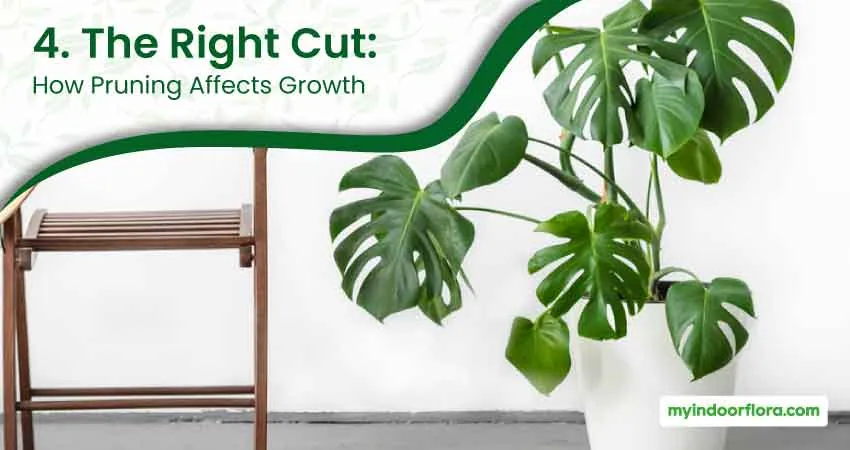
| Mistake | Effects |
|---|---|
| Cutting too close to a node | Stunted growth |
| Using dull tools | Damaged stems, disease susceptibility |
| Over-pruning | Stress, reduced photosynthesis |
Proper Pruning Techniques
The Ideal Cut
- Angle: Always cut at a 45-degree angle to avoid water pooling on the cut surface.
- Location: Make your cut just above a node, where the plant has a better chance of healing itself.
Tools of the Trade
- Pruning Shears: Ideal for thicker stems.
- Scalpels or Sharp Knives: Good for finer, more precise cuts.
| Tool | Best For |
|---|---|
| Pruning Shears | Thick stems |
| Scalpel | Thin stems, precise cuts |
| Gloves | Protection during pruning |
When to Prune
- Growing Season: Late spring to early summer is ideal.
- Signs of Stress: If your plant is already stressed, it’s not a good time to prune.
Solutions for Pruning Problems
- Regular Inspection: Keep an eye on your Monstera and plan to prune when you start noticing overgrowth or dead leaves.
- Professional Help: If you’re unsure, don’t hesitate to seek advice from a professional.
5. A Helping Hand: The Role of Support Structures
Sometimes, even plants need a little support from their friends—that’s where support structures come into play. If your Monstera is growing sideways, it might just be crying out for a sturdy support system.
In its natural rainforest habitat, the Monstera deliciosa has plenty of trees and vines to climb and lean on. But inside your living room? Not so much. It’s up to you to provide the necessary structures.
When Monsteras can’t find something to cling to, they start to sprawl out, often leading to sideways growth. This is because their aerial roots are looking for something to attach to and, not finding it, the plant grows in any direction it can.
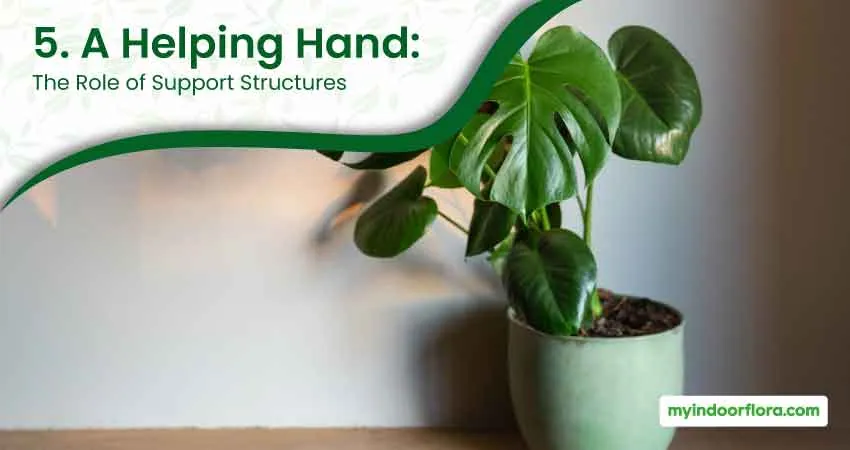
| Condition | Result | Solution |
|---|---|---|
| No Support | Sideways growth | Add support structures |
| Weak Support | Drooping/Sideways Growth | Reinforce or replace support |
Types of Support Structures
Moss Poles
Moss poles mimic the natural environment of a Monstera by providing a moist, textured surface for aerial roots to cling to. They are the most commonly used support for Monsteras.
Trellises
Wooden or metal trellises offer a flat structure for your Monstera to climb. These can be particularly effective for larger Monsteras.
DIY Options
Some folks use a combination of stakes and fishing lines or even repurpose old ladders as unique support structures.
| Type | Benefits |
|---|---|
| Moss Poles | Mimic natural environment, good for aerial roots |
| Trellises | Effective for larger plants, aesthetic options available |
| DIY Options | Cost-effective, customizable |
How to Support Your Monstera
- Installation: Whether it’s a moss pole or a trellis, make sure it’s securely anchored in the potting soil.
- Training the Plant: Gently attach the Monstera’s stem to the support using soft plant ties or clips.
- Ongoing Care: As the plant grows, you’ll need to reposition the ties and possibly extend the support structure.
6. It’s in the Genes: Genetic Factors in Growth
Sometimes, despite your best efforts, your Monstera may still grow sideways. It could be something you can’t control: genetics.
There are several species and cultivars of Monstera, each with its own genetic predispositions. Some are naturally more inclined to grow upwards, while others may have a tendency to grow sideways.
Some Monsteras have genetic traits that make them more prone to sideways growth. These can include shorter internodes, weaker stems, and even a natural tendency for vine-like growth.

| Variety | Typical Growth Pattern |
|---|---|
| Monstera Deliciosa | Mostly upright |
| Monstera Adansonii | Tendency for vine-like growth |
| Monstera Dubia | Climbing variety, needs support |
Solutions for Genetic Challenges
Pruning and Propagation
If you have a Monstera variety that is genetically predisposed to grow sideways, strategic pruning can encourage more upright growth. Propagation allows you to create new plants from the pruned sections, which you can train to grow upright from an early stage.
Selective Cultivation
Another approach is to selectively cultivate your Monstera, choosing stems that show more upright growth for propagation. Over time, you can essentially “train” your Monstera population to grow more vertically.
When to Consult a Botanist
If you’re really stumped by your Monstera’s growth pattern, it might be worth consulting a botanist. They can help identify the specific variety you have and offer tailored advice for encouraging upright growth.
7. Soil and Container Essentials: More than Just Dirt
The soil you use for your Monstera is far from trivial. It’s the plant’s home, its food source, and its support system all rolled into one. Let’s dig into this topic, shall we?
Soil is more than just dirt; it’s a complex structure of minerals, organic matter, water, and air. A well-structured soil provides the roots with adequate room to grow and allows for good drainage, which is vital for preventing root rot.
Monstera prefers a slightly acidic to neutral soil pH, typically between 5.5 and 7.0. Incorrect pH levels can lead to nutrient imbalances, affecting your Monstera’s growth.
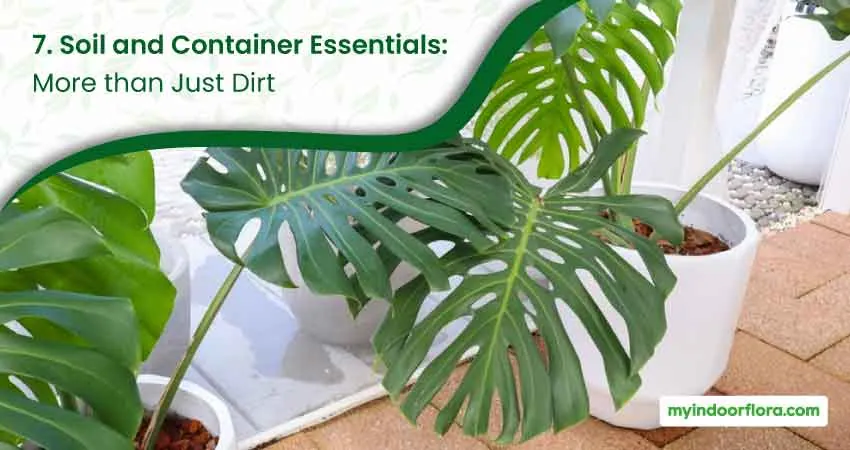
| Soil Property | Importance |
|---|---|
| Texture | Affects drainage and aeration |
| pH Level | Impacts nutrient availability |
| Organic Matter | Provides nutrients and improves soil structure |
Soil Amendments: Tweaking for Perfection
Common Soil Amendments
- Perlite: Improves aeration and drainage.
- Vermiculite: Increases water and nutrient retention.
- Compost: Adds essential organic matter and nutrients.
How to Amend Your Soil
- Testing: Use a soil test kit to find out what your soil is lacking.
- Application: Follow the directions on the soil amendment package.
- Mixing: Ensure the amendments are well-mixed with the existing soil.
8. Pesky Problems: When Bugs Get Involved
Even a well-cared-for Monstera can fall prey to pests. These little critters can weaken your plant and exacerbate the sideways growth issue.
- Spider Mites: Tiny bugs that suck the sap from leaves.
- Aphids: Small insects that feed on new growth.
- Mealybugs: White, cottony pests that are often found on the undersides of leaves.
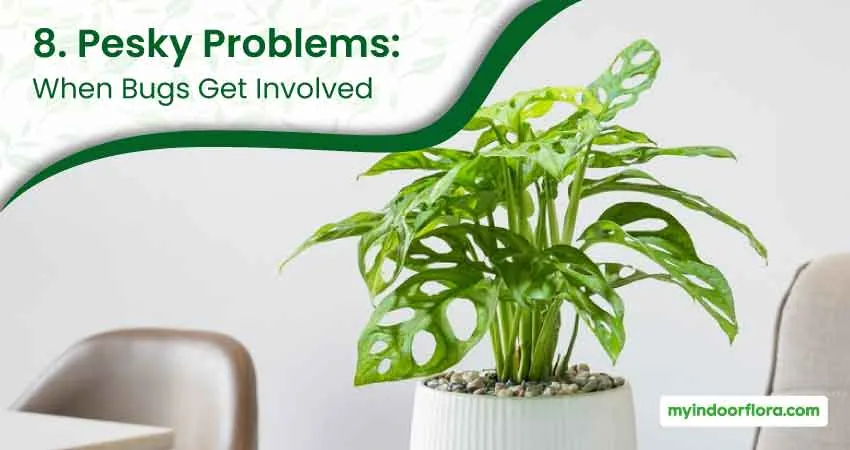
| Pest | Signs |
|---|---|
| Spider Mites | Webbing, yellow spots on leaves |
| Aphids | Curled leaves, sticky residue |
| Mealybugs | White cottony patches |
Pest Control Solutions
Organic Methods
- Neem Oil: A safe and effective organic pesticide.
- Insecticidal Soap: Effective for soft-bodied insects like aphids.
Chemical Treatments
- Pesticide Sprays: Effective but should be a last resort due to their environmental impact.
- Systemic Insecticides: These are absorbed by the plant and can provide long-term protection.
How to Encourage Your Monstera to Stand Tall
Now that we’ve covered everything from lighting and space to soil and pests, let’s wrap up with some general tips to encourage that coveted upright growth in your Monstera.
- Adequate Lighting: Ensure your Monstera gets bright, indirect light.
- Enough Space: Regularly check for signs of a root-bound plant and repot as necessary.
- Proper Watering: Stick to a consistent watering schedule based on soil moisture.
- Nutrient Balance: Use a well-rounded fertilizer and amend soil as needed.
- Effective Pruning: Regularly trim to promote upward growth.
- Sturdy Support: Install support structures for your Monstera to climb.
- Pest Management: Keep an eye out for common pests and treat as necessary.
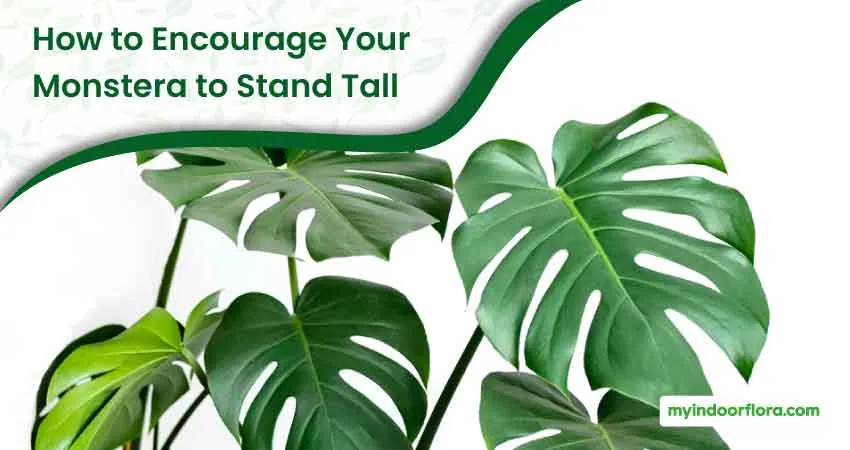
By following these guidelines and understanding the underlying causes of sideways growth, you’ll be well-equipped to help your Monstera reach its full, upright potential. Happy planting! 🌱
Frequently Asked Questions
How long does it take for a Monstera to correct its growth direction after making adjustments?
Correcting a Monstera’s growth direction can take a few weeks to a couple of months, depending on the severity of the issue and the plant’s overall health. Consistent care is key to seeing improvements.
Can improper soil pH cause my Monstera to grow sideways?
While improper soil pH can cause a host of growth issues, it’s less likely to directly cause sideways growth. However, poor nutrient absorption due to incorrect pH levels could weaken the plant, contributing indirectly to sideways growth.
What are the early signs that my Monstera will start growing sideways?
Early signs could include the plant leaning to one side, aerial roots growing longer in search of support, and leaves turning toward a single light source rather than growing uniformly.
Can a Monstera return to normal growth after being root-bound for an extended period?
Yes, a Monstera can recover from being root-bound, although it may take some time for normal growth patterns to resume. Repotting the plant in a larger container and properly aerating the soil will aid recovery.
Does the direction of natural light affect the growth direction of my Monstera?
Yes, the direction of natural light can influence your Monstera’s growth. If the light comes from only one direction, the plant is likely to grow towards that light, which can result in sideways growth.
Can I use growth hormones to correct sideways growth?
While growth hormones can stimulate certain types of growth, they are not typically used to correct sideways growth in Monsteras. The focus should be on rectifying the environmental factors causing the issue.
Is there a limit to how tall a Monstera can grow indoors?
While Monsteras can grow up to 65 feet in the wild, indoor conditions usually limit them to around 6 to 10 feet. However, growth can be restricted by pot size, light conditions, and other environmental factors.
